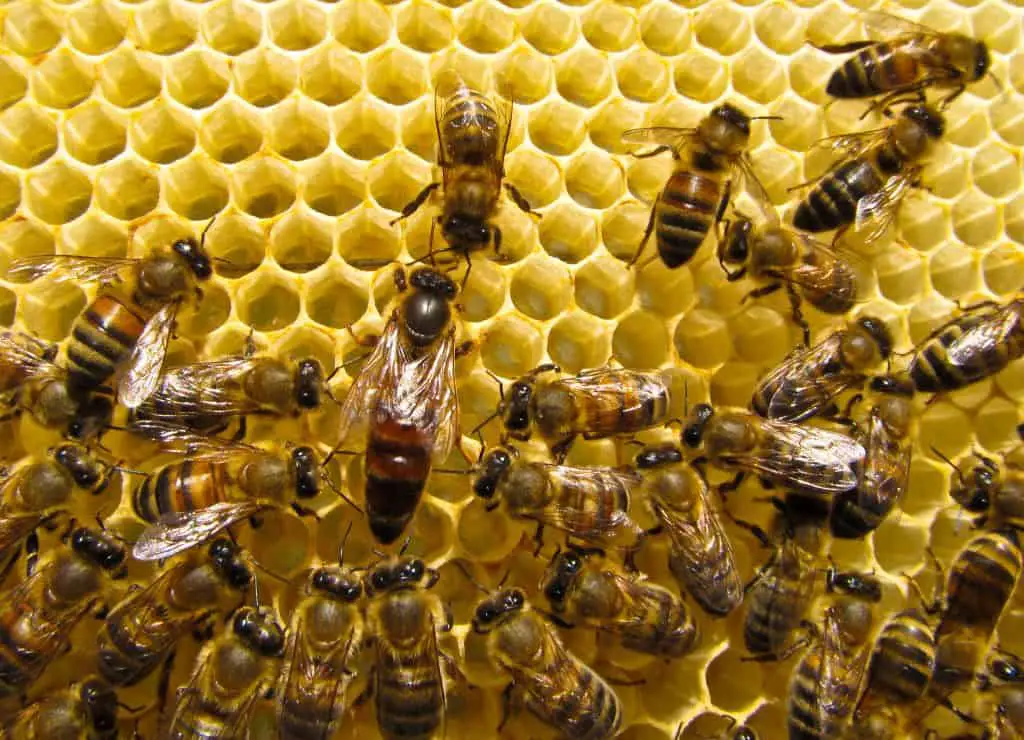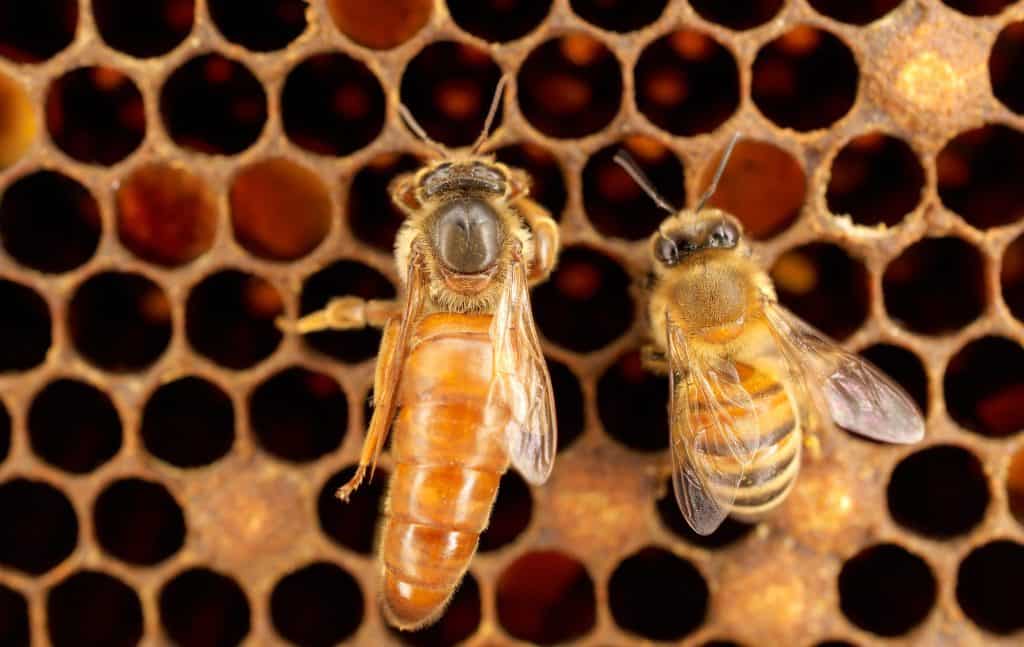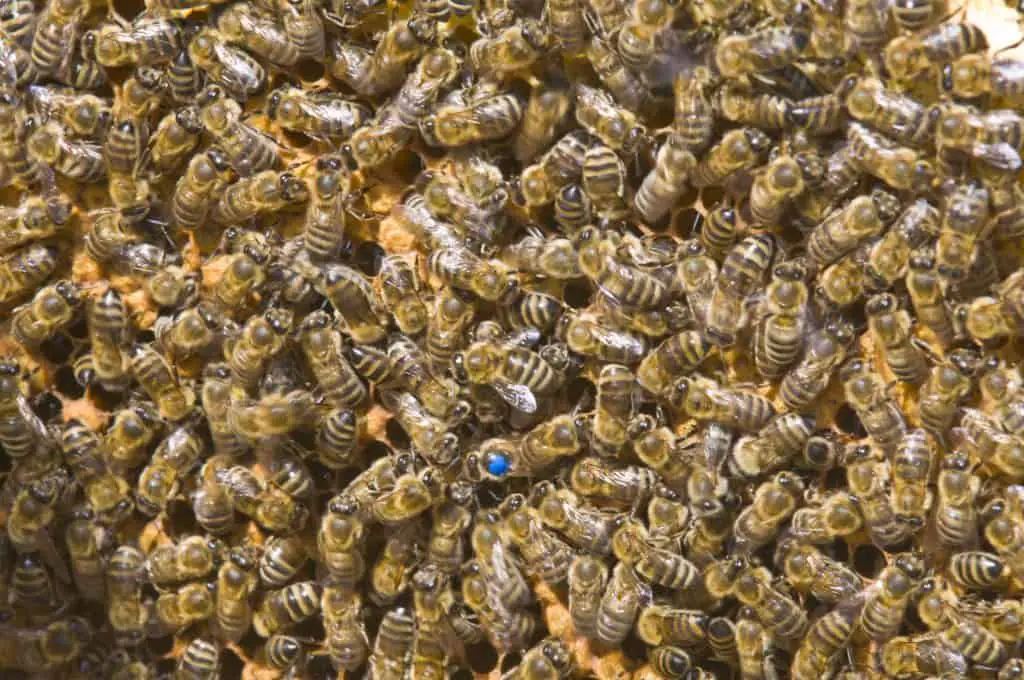If you know a bit about bees, you know how important queen bees are. They produce all the offspring for a hive, meaning that without them, the colony will die off. There are many reasons one might want to identify a queen bee, including simple curiosity, needing to check a queen bee for health, and ensuring that the queen bee is not killed in the process of any testing for parasites.
What is a Queen Bee?

A queen bee is a large, fertile, female bee who produces all the eggs for a given colony. While worker bees are infertile, the queen bee is completely fertile and mates with male drones to create fertilized eggs that develop into worker bees, and unfertilized eggs that develop into drone bees.
Why Are Queen Bees Important?
Queen bees are important because they produce all of the offspring for a colony of bees. There are many reasons one might want to identify a queen bee, either as a regular person who is curious about bees or as a beekeeper.
Some people are simply fascinated with queen bees and want to identify them because they are interesting creatures. Queen bees are intriguing because they are so much larger than other bees and because they are so important for a colony’s health.
Beekeepers need to be able to identify queen bees so that they do not accidentally kill them during inspections or moving parts of the hive. If a queen bee is killed, she will have to be replaced or the colony will die off without any bee to produce offspring.
When Can You See a Queen Bee?
In domesticated honey bee hives, you can see a queen bee year round, as they do not hibernate like other species. However, if you do not own domesticated honey bees, spotting a queen may be more rare.
In other species of bees, queens are only outside the hive for a short period of time in the spring. Queens will be the only bees that are alive in the spring, and you’ll often see them stumbling around on the ground when they first emerge from hibernation, looking for nectar to feed on.
It is important not to bother queen bees when they are emerging from hibernation. While they are tired and malnourished from hibernation, they could still sting you if they feel threatened. If you are concerned about a queen bee that you find, simply pluck a flower from nearby and place it carefully in front of her so that she has something to eat.
What Does a Queen Bee Look Like?

Queen bees are fairly different looking from worker bees or drone bees. Their bodies are designed to produce offspring rather than forage or defend their nest, meaning they have a few different features from workers or drones.
Firstly, they are much larger than worker bees, with a longer abdomen that makes their wings look short. While worker bees’ wings extend to the end of their abdomen, queen bees’ wings only come about halfway down their abdomen.
Additionally, their abdomen is typically a darker color than that of worker bees, and does not have as much hair on it. It is also pointier at the end than those of worker bees.
Queen bees also typically have legs that are lighter in color than those of worker bees. Their legs also tend to splay out around them, rather than being directly underneath them like workers or drones.
How to Find a Queen Bee in a Hive?
The most important thing in finding your queen bee within your hive is to know where to look. The queen bee will almost always be in the vicinity of newly laid eggs, rather than in the combs filled with honey or capped brood.
Look for open cells with eggs or larvae inside that have not yet been capped with beeswax. These are the most recently laid young, and the queen will be close to this area.
Your queen is less likely to be out in the open than other bees. She is shy and will probably be found hiding in a dark area deep inside the hive so that she will not be disturbed while laying eggs or caring for herself.
If you see your bees moving in groups to clear a path for another bee, that bee is likely the queen. Workers and drones always move out of the way to allow the queen to pass, so if you see this happening, your queen is likely nearby.
The queen is also the only bee that might just be sitting in one place and not doing any work. Because her only job is to lay eggs, when she is not laying eggs she has nothing else to do and will simply sit in one place to rest and eat.
If you see some of your bees seeming to feed another bee, it is likely that that bee is the queen. Worker bees take care of all of the queen’s needs for her, including feeding her. If your bees seem to be carrying food to one specific place and giving it to another bee, that is probably your queen.
How Do Beekeepers Keep Track of their Queens?

Many beekeepers mark their queen bees to make it easier to identify them and to tell how old they are. Most beekeepers use paint pens or regular acrylic paint to mark their queens, which is completely safe for the bees.
The system of marking the bees for age is that certain colors correspond to what year the queen was born in. If the queen was born in a year that ends in one or six, she is marked with white paint. If her birth year ended in two or seven, yellow is used. Red is for years ending in three or eight, green for four or nine, and blue for five or zero.
This system helps beekeepers identify their queen bees within their hives, and also know how old their queen is and when they may need to replace her.
How to Mark a Queen Bee
If you’re fascinated by the idea of marking your queen bee to make her easier to find, the good news is that it is not very difficult to mark queen bees. You need to have your paint or paint pens ready before you begin the process so that you can easily mark the queen as soon as you have caught her.
First, identify your queen bee by her large size, short wings, and pointy abdomen. Pick her up gently with gloved hands by her thorax or wings, being very careful not to crush her or tear her wings. If she starts to struggle, let her go so that you do not hurt her. During the marking process, you’ll want to hold the queen over an exposed honeycomb so that if you drop her she will fall back into the hive rather than somewhere that you might lose her.
Once you have your queen securely in your hands, you want to dab a little dog of paint right between her two front legs. It should go on her thorax, the part of her body between her head and her abdomen.

